Autonomous driving chip research: In addition to computing power, core IP, software stacks, AI training platforms, etc. are becoming more and more important
L2.5 and L2.9 have achieved mass production for vehicles running on the road, and mass production of L3 and L4 in limited scenarios has become a goal for OEMs in the next stage. In March 2022, the U.S. National Highway Traffic Safety Administration (NHTSA) issued final rules eliminating the need for automated vehicle manufacturers to equip fully autonomous vehicles with manual driving controls to meet crash standards. The United States is expected to introduce more important policies for autonomous driving in the future to guide L3/L4 autonomous driving on the road.
In this context, ADAS/autonomous driving chips have seen a wave of upgrades, and many chip makers have launched or planned to unveil high computing power chips. In January 2022, Mobileye introduced the EyeQ? Ultra?, the company’s most advanced, highest performing system-on-chip (SoC) purpose-built for autonomous driving. As unveiled during CES 2022, EyeQ Ultra maximizes both effectiveness and efficiency at only 176 TOPS, with 5 nanometer process technology. Although it looks less potent than chips from rivals Qualcomm and NVIDIA, the cost-effective and high-energy-efficiency EyeQ? Ultra? may still be favored by OEMs.
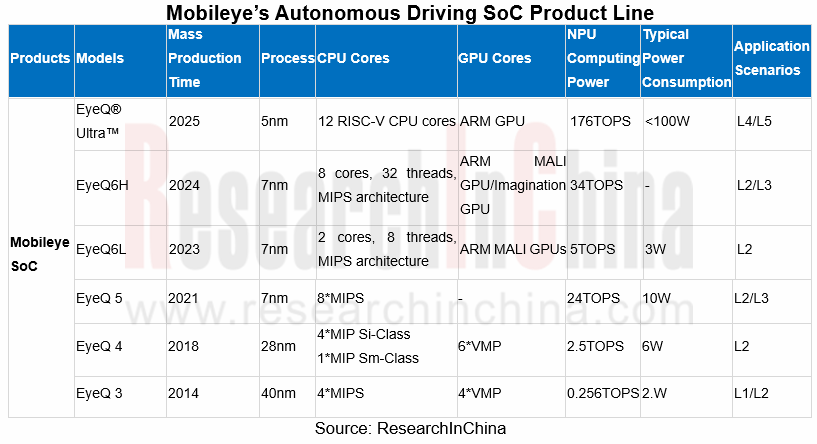
In addition to computing power, self-developed core IP is the focus of competition for major SoC vendors
SoC chips, which are mostly involved with heterogeneous design, include different computing units such as GPU, CPU, acceleration core, NPU, DPU, ISP, etc. Generally speaking, computing power cannot be simply evaluated from the chip alone. Chip bandwidth, peripherals, memory, as well as energy efficiency ratio and cost should be also taken into account. At the same time, the development tool chain of SoC chips is very important. Only by forming a developer ecosystem can a company build long-term sustainable competitiveness.
In chip design, the configuration of heterogeneous IP is crucial, and autonomous driving SoC chip vendors are constantly strengthening the research and development of core IP to maintain their decisive competitive edges. For example, NVIDIA upgraded its existing GPU-based product line to a three-chip (GPU+CPU+DPU) strategy:
? GPU: NVIDIA enjoys superiority in GPU and image processing derived from GPU;
? DPU: NVIDIA announced the completion of its acquisition of Mellanox Technologies, Ltd., an Israeli chip company, for a transaction value of $7 billion and launched the BlueField?-3 data processing unit (DPU). DPU is a programmable electronic component with the versatility and programmability of a central processing unit (CPU), dedicated to efficiently handling network data packets, storage requests or analysis requests;
? In terms of CPU, NVIDIA intended to acquire the semiconductor IP semiconductor ARM as an extension of its three-chip strategy, but it failed in the end. However, NVIDIA launched the Grace? CPU, an Arm-based processor that will deliver 10x the performance of today’s fastest servers on the most complex AI and high-performance computing workloads. NVIDIA's next-generation SOC, Atlan, is based on the ARM-based Grace CPU and Ampere Next GPU.
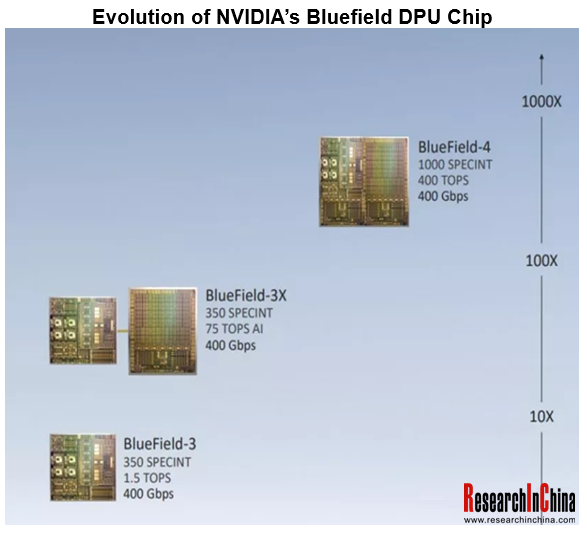
In terms of domestic vendors, Black Sesame Technologies has launched self-developed NeuralIQ ISP and DynamAI NN engine which is a deep neural network algorithm platform.
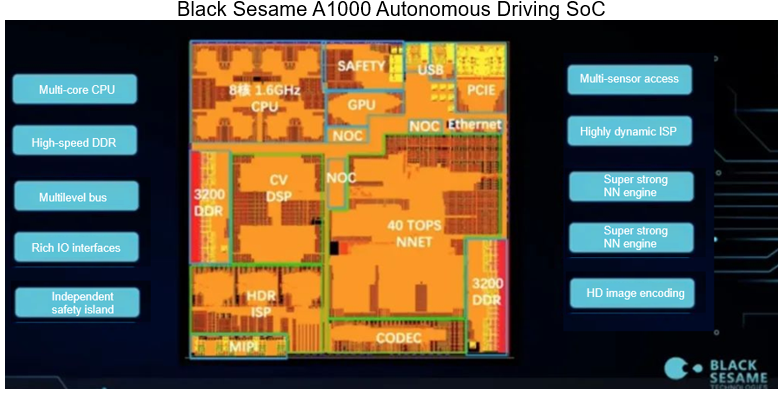
Cross-domain fusion and central computing platform chips will lead the evolution of the automotive EEA
Amid the evolution trend of the automotive EEA: "distributed architecture - domain centralized architecture - cross-domain fusion architecture - central computing platform", Tesla's latest version of Model X has achieved a certain degree of central cross-domain fusion computing. Model X's automotive central computing platform includes two FSD chips, an AMD Ryzen CPU chip and an AMD RDNA2 GPU. The FSD chip and AMD CPU/GPU chip communicate through the PCIe interface and are isolated from each other.
Integrating multiple chips such as CPU, GPU, and FSD into one SoC chip through Chiplet technology will further reduce the chip communication delay. Tesla has reportedly partnered with Samsung on a new 5nm chip for autonomous driving and cockpit SoC chip integration.
The industry’s giants like NVIDIA and Qualcomm have all begun to implement cross-domain integration of autonomous driving and cockpits. For example, NVIDIA has launched DRIVE Concierge and DRIVE Chauffeur for smart cockpits and autonomous driving respectively. DRIVE IX can realize the fusion of algorithms in the cockpit. Based on the powerful software stack tools, NVIDIA's next-generation Ampere architecture (Atlan SoC) will conduct the simultaneous control over autonomous driving and intelligent cockpit with a single chip.
In February 2022, Chinese SoC company Horizon Robotics announced that it will cooperate with UAES to preinstall and mass-produce cross-domain integrated automotive computing platforms.
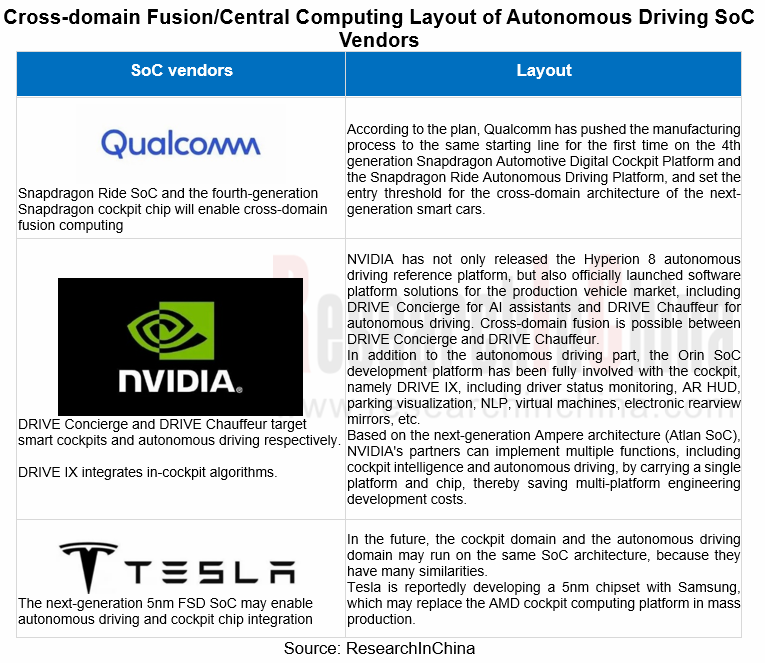
SoC vendors accelerate the layout of autonomous driving AI data training
Autonomous driving datasets are critical for training deep learning models and improving algorithm reliability. SoC vendors have launched self-developed AI training chips and supercomputing platforms. Tesla has launched the AI training chip D1 and the "Dojo" supercomputing platform, which will be used for the training of Tesla's autonomous driving neural network.
Besides, training algorithm models are becoming more and more important, including 2D annotation, 3D point cloud annotation, 2D/3D fusion annotation, semantic segmentation, target tracking, etc., such as the NVIDIA Drive Sim autonomous driving simulation platform, the Horizon Robotics "Eddie" data closed loop training platform, etc.
Foreign chip vendors:
? Tesla has launched Dojo supercomputing training platform, using Tesla's self-developed 7nm AI training chip D1 and relying on a huge customer base to collect autonomous driving data, so as to achieve model training for deep learning systems. At present, Tesla Autopilot mainly uses 2D images + annotations for training and algorithm iteration. Through the Dojo supercomputing platform, Autopilot can fulfill training through 3D images + time stamps (4D Autopilot system). The 4D Autopilot system will be predictable, and mark the 3D movement trajectory of road objects to enhance the reliability of autonomous driving functions.
? NVIDIA has announced NVIDIA Omniverse Replicator, an engine for generating synthetic data with ground truth for training AI networks. NVIDIA also has the most powerful training processor - the NVIDIA A100.
? The map data of Mobileye's REM has covered the world. In China, Mobileye has solved the compliance problem of map data collection in China through a joint venture with Tsinghua Unigroup. Intel acquired Moovit to enhance the strength and data differentiation of REM, extend the traditional HD map data from the roadside to the user side, start from the perception redundancy of assisted autonomous driving and improve the efficiency of path planning. Intel launched its self-developed flagship AI chip - Ponte Vecchio, which will spread to Mobileye's EyeQ6 (planned for mass production in 2023). In the field of AI and servers, Intel will challenge Nvidia with CO-EMIB technology.
Domestic chip vendors:
? In order to solve the long-tail problem of autonomous driving, Horizon Robotics has built a complete data closed-loop platform to iterate algorithms and improve system capabilities. Horizon Robotics has launched the "Eddie" data closed loop training platform.
? Huawei has introduced "Octopus" autonomous driving open platform, focusing on the four most critical elements of autonomous driving development - hardware, data, algorithms and HD maps to build a data-centric open platform which prompts closed-loop iterations of autonomous driving. Huawei's Ascend 910 competes with the NVIDIA A100 as the world's top AI training chip. Huawei has also launched the AI training cluster Atlas 900.
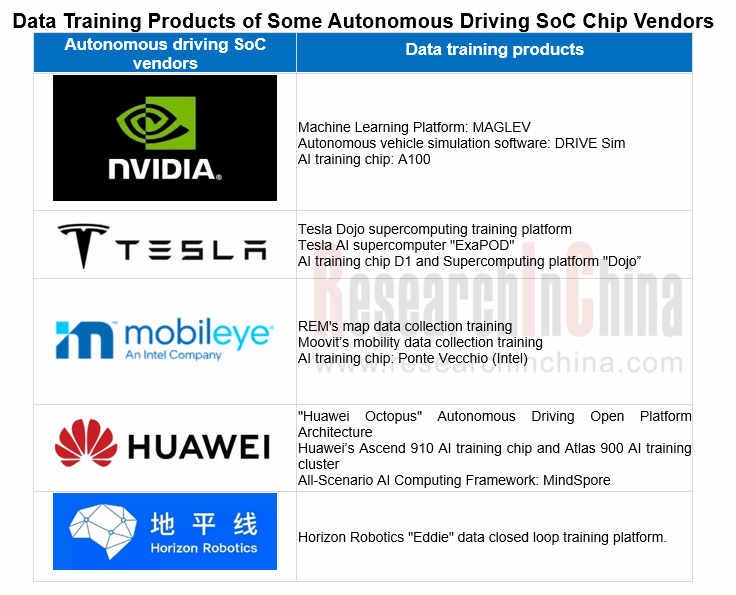
The world's leading autonomous driving AI training chips include: Intel Ponte Vecchio, NVIDIA A100, Tesla D1, Huawei Ascend 910, Google TPU (v1, v2, v3), Cerebras Wafer-Scale Engine, Graphcore IPU, etc.
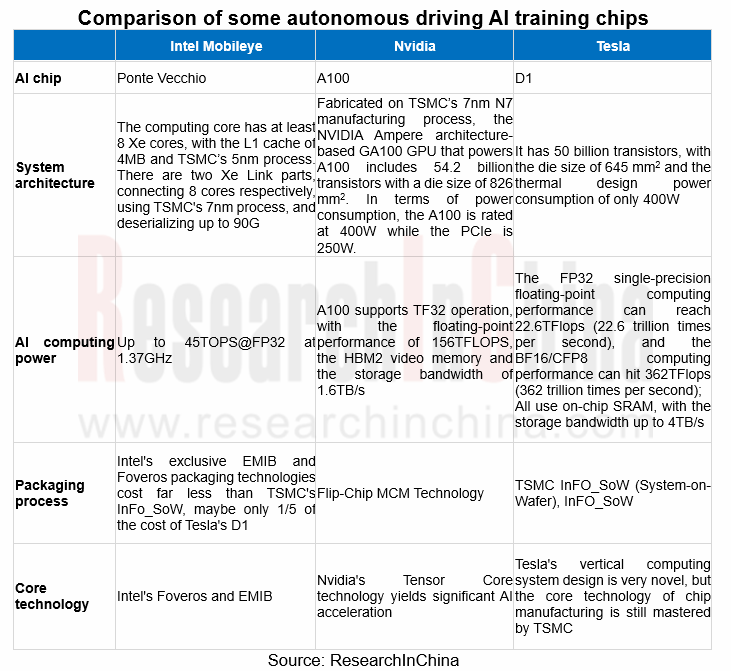
New Energy Vehicle Thermal Management System Industry Research Report, 2025-2026
Policy and Regulation Drive: Promoting the Development of Electric Vehicle Thermal Management Systems towards Environmental Compliance, Active Safety Protection, and Thermal Runaway Management
Accord...
Intelligent Vehicle Redundant Architecture Design and ADAS Redundancy Strategy Research Report, 2025-2026
Research on Redundant Systems: Septuple Redundancy Architecture Empowers High-Level Intelligent Driving, and New Products Such as Corner Modules and Collision Unlock Modules Will Be Equipped on Vehicl...
Passenger Car Mobile Phone Wireless Charging Research Report, 2025
Automotive Wireless Charging Research: Domestic Installation Rate Will Exceed 50%, and Overseas Demand Emerges as Second Growth Driver.
The Passenger Car Mobile Phone Wireless Charging Research Repor...
Automotive 4D Radar Industry Research Report 2025
4D radar research: From "optional" to "essential," 4D radar's share will exceed 50% by 2030.
1. 4D imaging radar has transformed from an "optional" to a "must-have" sensor.
4D radar adds the detecti...
China Automotive Multimodal Interaction Development Research Report, 2025
Research on Automotive Multimodal Interaction: The Interaction Evolution of L1~L4 Cockpits
ResearchInChina has released the "China Automotive Multimodal Interaction Development Research Report, 2025"...
Automotive Vision Industry Report, 2025
Automotive Vision Research: Average Camera Installation per Vehicle Reaches 5.2 Units, and Front-View Tricam Installation Exceeds 1.2 Million Sets.
From January to September 2025, the total installa...
Automotive Infrared Night Vision System Research Report, 2025
Automotive night vision research: The rise of infrared AEB, with automotive infrared night vision experiencing a 384.7% year-on-year increase from January to September.
From January to September 2025...
New Energy Vehicle Cross-Domain (Electric Drive System and Powertrain Domain) Integration Trend Report 2025-2026
Electric Drive and Powertrain Domain Research: New technologies such as three-motor four-wheel drive, drive-brake integration, and corner modules are being rapidly installed in vehicles.
Electric dri...
Analysis on Desay SV and Joyson Electronic's Electrification, Connectivity, Intelligence and Sharing, 2025
Research on Desay SV and Joyson Electronic: Who is the No.1 Intelligent Supplier?
Both Desay SV and Joyson Electronic are leading domestic suppliers in automotive intelligence. "Analysis on Desay SV ...
OEMs and Tier 1 Suppliers' Cost Reduction and Efficiency Enhancement Strategy Analysis Report, 2025
ResearchInChina released the "OEMs and Tier 1 Suppliers' Cost Reduction and Efficiency Enhancement Strategy Analysis Report, 2025", summarizing hundreds of cost reduction strategies to provide referen...
Automotive Fixed Panoramic Sunroof and Smart Roof Research Report, 2025
With the intelligent application of car roofs as the core, this report systematically sorts out a series of new products such as fixed panoramic sunroof/openable sunroof, ceiling screen, roof ambient ...
Automotive-Grade Power Semiconductor and Module (SiC, GaN) Industry Research Report, 2025
SiC/GaN Research: Sales volume of 800V+ architecture-based vehicles will increase more than 10 times, and hybrid carbon (SiC+IGBT) power modules are rapidly being deployed in vehicles.
Sales volume o...
Cockpit Agent Engineering Research Report, 2025
Cockpit Agent Engineering Research: Breakthrough from Digital AI to Physical AI
Cockpit Agent Engineering Research Report, 2025 starts with the status quo of cockpit agents, summarizes the technical ...
Prospective Study on L3 Intelligent Driving Technology of OEMs and Tier 1 Suppliers, 2025
L3 Research: The Window of Opportunity Has Arrived - Eight Trends in L3 Layout of OEMs and Tier 1 Suppliers
Through in-depth research on 15 OEMs (including 8 Chinese and 7 foreign OEMs) and 9 Tier 1 ...
China Commercial Vehicle IoV and Intelligent Cockpit Industry Research Report 2025
Commercial Vehicle IoV and Cockpit Research: The Third Wave of Passenger Car/Commercial Vehicle Technology Integration Arrives, and T-Box Integrates e-Call and 15.6-inch for Vehicles
I. The third wav...
Intelligent Vehicle Electronic and Electrical Architecture (EEA) and Technology Supply Chain Construction Strategy Research Report, 2025
E/E Architecture Research: 24 OEMs Deploy Innovative Products from Platform Architectures to Technical Selling Points
According to statistics from ResearchInChina, 802,000 passenger cars with domain...
Research Report on Intelligent Vehicle Cross-Domain Integration Strategies and Innovative Function Scenarios, 2025
Cross-Domain Integration Strategy Research: Automakers' Competition Extends to Cross-Domain Innovative Function Scenarios such as Cockpit-Driving, Powertrain, and Chassis
Cross-domain integration of ...
China Autonomous Driving Data Closed Loop Research Report, 2025
Data Closed-Loop Research: Synthetic Data Accounts for Over 50%, Full-process Automated Toolchain Gradually Implemented
Key Points:From 2023 to 2025, the proportion of synthetic data increased from 2...